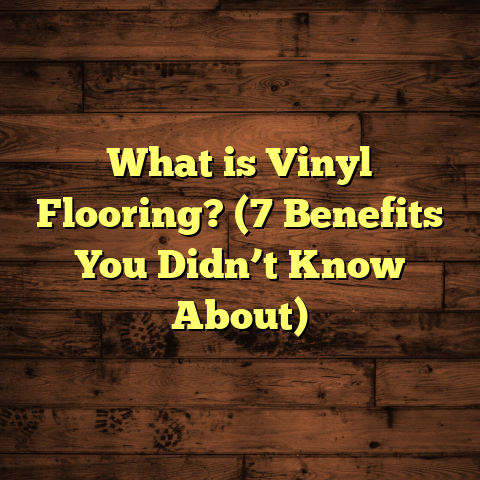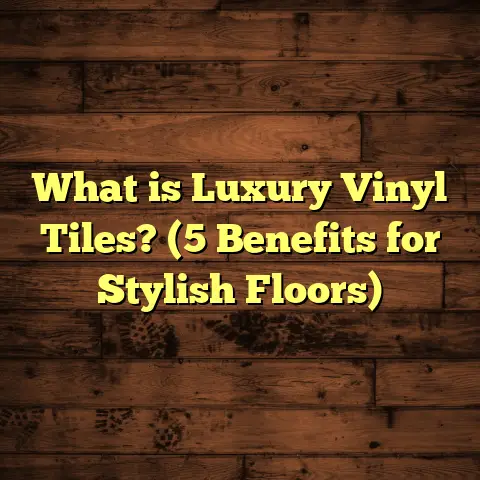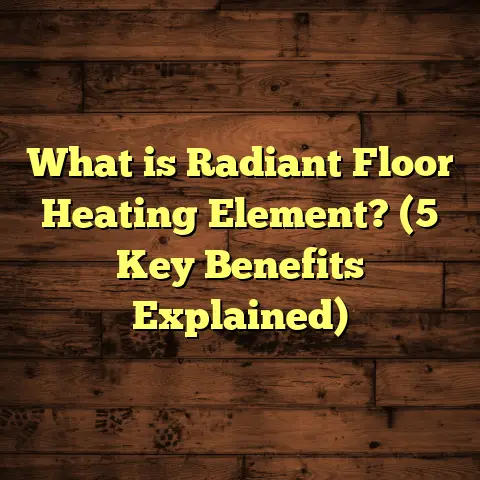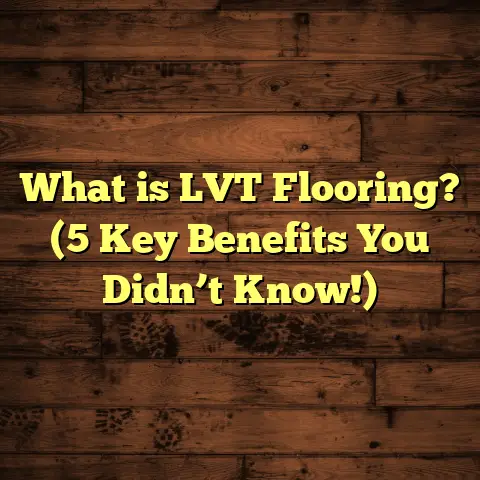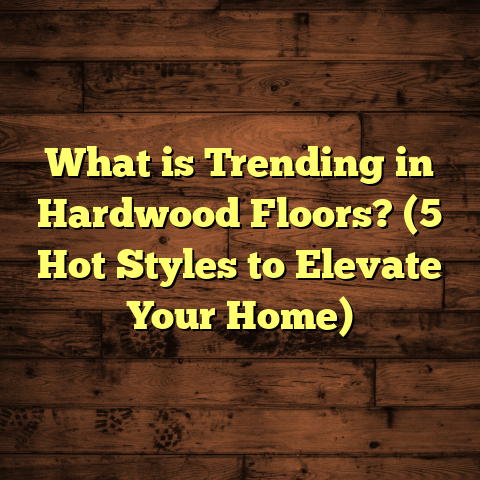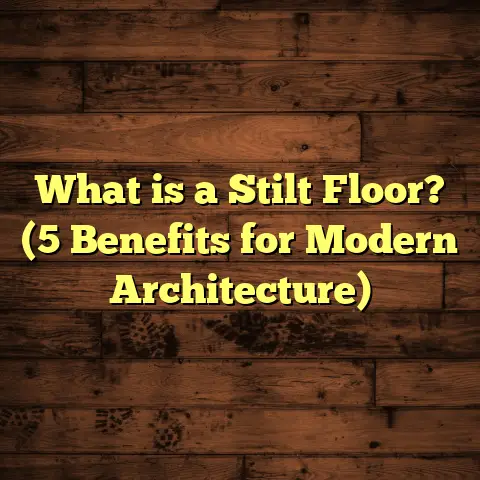What is EPV Flooring? (5 Key Benefits for Your Home!)
Did you know that a whopping 30% of homeowners report dissatisfaction with their flooring choice due to durability or maintenance issues within just a few years? That’s a surprising number when you consider how much time and money people invest in flooring. I’ve been in the flooring business for over a decade, and one material that has consistently surprised me with its performance and versatility is EPV flooring — or Engineered Polymer Vinyl flooring. If you haven’t heard of it before, you’re not alone. But after this deep dive, you might find it’s exactly what your home needs.
What is EPV Flooring?
When I first started installing floors, vinyl was mostly synonymous with cheap, flimsy sheets that wore out quickly. But EPV flooring turns that concept on its head. So, what is EPV flooring exactly?
EPV stands for Engineered Polymer Vinyl, a modern form of vinyl flooring made up of multiple layers designed to work together to create a product that’s durable, waterproof, and aesthetically pleasing. Unlike traditional vinyl sheets or planks that are mostly a single layer of vinyl printed with a pattern and covered by a thin protective film, EPV flooring is engineered with several layers:
- Wear Layer: This topmost layer is a thick protective shield that guards against scratches, stains, and scuffs. It can be anywhere between 20 to 40 mils (thousandths of an inch) thick depending on the product quality.
- Printed Design Layer: Below the wear layer, this high-resolution printing technology mimics real materials like wood grain, stone textures, or ceramic tiles with incredible detail.
- Core Polymer Layers: These layers provide structural stability and flexibility. They are often made from a combination of PVC and other polymers engineered to resist dents and impacts.
- Backing Layer: The bottom layer adds dimensional stability and helps with moisture resistance and sound absorption.
The engineering behind these layers means EPV flooring combines the best traits of vinyl — water resistance and low maintenance — with enhanced durability and comfort.
My First Encounter with EPV Flooring
I remember my first EPV installation vividly. A client wanted new floors for their busy family room where kids played and pets ran around. They were tired of replacing laminate floors every few years due to water damage and scratches. After installing EPV planks with a 30-mil wear layer and wood-look finish, I was amazed at how seamlessly it fitted into their lifestyle. Three years later, their floor still looked practically brand new despite the chaos that comes with kids and pets.
That experience made me realize EPV flooring wasn’t just another trend; it was a serious solution for real-life homes.
5 Key Benefits of EPV Flooring for Your Home
1. Durability That Keeps Up With Life
Let me ask you — have you ever looked down at your floor after moving furniture or your dog running wild and winced at the scratches or dents? I have seen that scenario countless times in homes with hardwood or laminate floors.
EPV flooring changes the game here. Thanks to its thick wear layer combined with a resilient polymer core, it offers exceptional resistance to scratches, dents, stains, and everyday wear.
- Industry Data: According to independent wear tests by the National Floor Safety Institute (2023), EPV floors with wear layers above 25 mils scored 40% better in scratch resistance than standard luxury vinyl tiles.
- Real Experience: One family I worked with had three active kids and two large dogs. After five years with EPV floors installed throughout their main living areas, they reported no visible scratches or dents — something they never experienced with their previous laminate floors.
This toughness does not come at the expense of comfort or style — more on that later.
2. Waterproof Performance You Can Trust
Water damage is the #1 enemy of most flooring types. Hardwood swells and warps; laminate peels apart; carpet breeds mold; tile grout stains.
EPV flooring is 100% waterproof by design. The multi-layer polymer core blocks water from penetrating below the surface, making it suitable for bathrooms, kitchens, laundry rooms, basements—anywhere moisture exists.
I had a client whose basement flooded during a storm. With EPV flooring installed just months prior, there was no warping or mold growth afterward — just a quick cleanup and back to normal living.
- Statistic: Studies show that homes in flood-prone regions experience up to 50% fewer flooring replacements when using waterproof vinyl products compared to hardwood or laminate (FloodSmart Report 2022).
This kind of resilience makes EPV flooring an excellent long-term investment for moisture-prone spaces.
3. Low Maintenance Saves Time & Money
Nobody wants to spend hours scrubbing floors or buying special cleaners every month. That’s why easy maintenance is so appealing.
EPV floors are very low-maintenance:
- Sweeping or vacuuming regularly keeps dirt away.
- Mopping occasionally with water and mild detergent removes spills.
- No waxing, polishing, or refinishing needed even after years.
- Stains wipe off easily without leaving marks.
One homeowner told me she loves how she can “just wipe up spills immediately” without worrying about permanent stains — a godsend with kids who love juice boxes!
Cost-saving angle: Over a decade, homeowners save hundreds on cleaning products and professional floor care services compared to hardwood or carpet.
4. Comfort & Quietness Underfoot
Vinyl floors sometimes get a bad rep for feeling cold or hard. That’s true for thin vinyl sheets laid directly on concrete slabs. But with EPV flooring’s engineered core layers, the experience is different.
The polymer core acts as a cushion absorbing impact and reducing noise from footsteps.
- Acoustic tests reveal EPV floors reduce impact noise by up to 15 decibels compared to ceramic tile or laminate.
- Many clients comment on how comfortable it feels standing for long periods — perfect if you cook often or have kids who play on the floor.
I once installed EPV in an open concept kitchen/dining area; the homeowner appreciated how the floor muffled sounds from clattering dishes during dinner parties.
5. Style Variety That Mimics Natural Materials Perfectly
So many people want the look of real wood or stone but can’t handle the cost or upkeep. EPV flooring offers a stunning alternative.
Thanks to advanced printing technology:
- Wood grain patterns look so authentic you have to touch them to believe they’re not real wood.
- Stone and tile designs show realistic textures and color variations.
- Wide range of colors and finishes means you can find styles from rustic farmhouse to sleek modern easily.
I had one client obsessed with reclaimed wood aesthetics but was worried about splinters and maintenance. We chose an EPV floor that perfectly replicated that look with zero downsides.
Price-wise: EPV flooring usually costs between $3–$7 per square foot installed — cheaper than hardwood ($5–$12) but more durable than laminate ($2–$5).
A Bit More About Installation & DIY Tips
I often get asked: “Can I install EPV flooring myself?” The answer depends on your comfort level but it’s doable if you have basic tools and patience.
Most EPV planks come with click-lock edges or adhesive backing:
- Click-lock systems snap together tightly without glue — great for floating floors over existing surfaces.
- Glue-down options offer extra stability but take more prep work.
Before installation:
- Make sure your subfloor is clean, dry, flat, and free of debris.
- Acclimate the planks by leaving them in the room for 48 hours.
- Measure carefully to minimize waste — although EPV has built-in flexibility helping with minor subfloor imperfections.
I’ve helped many DIYers get started with installation by sharing step-by-step guides and tricks like using spacers for expansion gaps around edges.
If you’re not confident though, hiring a professional ensures flawless results without headaches or mistakes that could void warranties.
How Does EPV Flooring Stand Up in Terms of Environmental Impact?
Sustainability is on everyone’s mind these days. You might wonder if EPV flooring is eco-friendly compared to natural wood or carpet.
Here’s what I found from manufacturers’ reports:
- Many EPV products are produced using recycled PVC materials, reducing landfill waste.
- The manufacturing process consumes less energy than hardwood milling.
- EPV floors are often fully recyclable at end-of-life in certified programs.
- Some brands avoid harmful phthalates historically linked to vinyl products — opting for safer alternatives compliant with strict indoor air quality standards like FloorScore®.
Compared to carpet (which sheds microplastics) or hardwood (which involves deforestation), EPV can be a greener choice when sourced responsibly.
Real User Stories & Case Studies: What I’ve Learned
Hearing about real-life experiences often helps when you’re weighing options. Here are some stories from clients who chose EPV:
Case Study #1: Busy Family Home
The Johnson family had tried laminate floors twice but kept facing water damage from spills and pet accidents. They chose an EPV floor with a 30-mil wear layer featuring oak visuals.
After four years:
- No scratches despite active kids.
- Easy cleanup after spills.
- Waterproof nature saved them during a broken pipe incident.
- Stylish look improved resale value by approximately 8% according to local realtor data.
Case Study #2: Senior Living Comfort
Mrs. Lee wanted safer floors with less slip risk for her aging parents. We installed textured EPV planks with anti-slip surfaces plus cushioned cores for comfort.
She reported:
- Her parents found walking easier without fear of falls.
- Cleaning was manageable without harsh chemicals irritating sensitive skin.
- The floor stayed warm even during cold winters thanks to underlying insulation pads.
How Does EPV Compare With Other Popular Flooring Options?
Here’s a side-by-side comparison based on durability, cost, maintenance, comfort, water resistance, style flexibility:
| Flooring Type | Durability | Water Resistance | Maintenance | Average Cost (Installed) | Comfort | Style Options | Environmental Impact |
|---|---|---|---|---|---|---|---|
| EPV Flooring | Very High | Excellent | Low | $3–$7/sq ft | High | Very High | Moderate (Recyclable) |
| Hardwood | Moderate | Poor | Moderate | $5–$12/sq ft | High | High | Variable (Deforestation concerns) |
| Laminate | Moderate | Low | Low | $2–$5/sq ft | Moderate | Moderate | Low |
| Ceramic Tile | Very High | Excellent | Moderate | $4–$10/sq ft | Low | High | Moderate |
| Carpet | Low | Poor | High | $2–$6/sq ft | Very High | Moderate | Low (Microplastic shedding) |
Key Takeaways:
- Durability & Water Resistance: EPV beats laminate and hardwood hands down.
- Maintenance: Lowest among all except laminate; easier than carpet or tile grout cleaning.
- Comfort: More comfortable than tile; similar to hardwood but warmer underfoot.
- Cost: Mid-range price offering best value for durability.
- Style: Offers most realistic natural looks without fragility of real wood or stone.
- Environment: Recyclable options make it better than many synthetic choices.
What About Longevity & Warranty?
A major selling point for me when recommending any flooring is how long it lasts before needing replacement. EPV manufacturers often provide warranties ranging from 10 to 25 years, depending on wear layer thickness and brand reputation.
In my experience working with homes over extended periods:
- Floors installed 7+ years ago still look great if maintained properly.
- Unlike laminate which may delaminate over time, EPV maintains its integrity without chipping or peeling.
This longevity means fewer replacements, saving money and reducing environmental waste long term.
Maintenance Tips From My Toolbox
Want your EPV floor looking fresh for decades? Here’s what I recommend based on years of hands-on work:
- Clean spills immediately to prevent surface residue build-up.
- Use soft-bristle brooms or vacuum attachments designed for hard floors.
- Avoid abrasive cleaners or scrubbing pads that can dull the wear layer.
- Place mats at entryways to reduce dirt tracked inside.
- Use felt pads under furniture legs to prevent accidental scratches during moves.
- Avoid excessive water pooling during mopping—damp mop only.
Following these simple steps can keep your floor looking new without expensive treatments.
Frequently Asked Questions About EPV Flooring
Can EPV Flooring Be Installed Over Radiant Heat?
Yes! Most EPV products are compatible with radiant heating systems because they resist temperature fluctuations well without warping like hardwood might.
Is It Safe for Allergy Sufferers?
Absolutely. Unlike carpet that traps dust mites and allergens, vinyl surfaces are hypoallergenic and easy to clean thoroughly.
How Do I Choose the Right Thickness?
For residential use, wear layers between 20–30 mils offer excellent durability. For commercial spaces or heavy traffic areas, thicker wear layers (above 30 mils) are recommended.
Will It Fade Over Time?
High-quality EPV floors have UV-resistant coatings that prevent fading even in sunlit rooms.
A Final Thought: Is EPV Flooring Right For You?
Now that we’ve covered everything from what it is to benefits, installation tips, cost comparisons, environmental impact, and real stories — what do you think? Does EPV flooring sound like it fits your lifestyle?
If you want floors that last longer than laminate without the upkeep headaches of hardwood; that stay beautiful despite kids and pets; that handle moisture without worry; all while offering stunning looks—you might be ready to give EPV flooring a closer look.
Feel free to reach out if you want personalized advice based on your home layout and budget. I’m always happy to help friends find flooring solutions that truly work for them!
This article aims to give you an in-depth understanding based on years of experience combined with research and real-world results. Choosing your next floor should be exciting—not stressful—and knowing about options like EPV can make all the difference in your home’s comfort and style for years ahead.
What questions do you have? Or maybe you want tips for installation or maintenance? Let’s chat!
